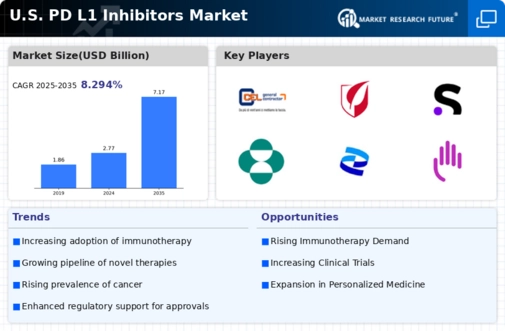Increasing Cancer Incidence
The rising incidence of various cancers in the US is a primary driver for the pd l1-inhibitors market. According to the American Cancer Society, an estimated 1.9 million new cancer cases are expected in 2025, which underscores the urgent need for effective treatment options. This growing patient population is likely to propel demand for innovative therapies, including pd l1-inhibitors, which have shown promise in enhancing immune responses against tumors. As healthcare providers seek to improve patient outcomes, the pd l1-inhibitors market is positioned to expand significantly, potentially reaching a valuation of $20 billion by 2027. The increasing focus on personalized medicine further emphasizes the importance of these therapies in addressing the unique needs of cancer patients.
Increased Awareness and Education
Increased awareness and education regarding cancer treatments are driving growth in the pd l1-inhibitors market. Healthcare professionals and patients are becoming more informed about the benefits of immunotherapy, leading to higher demand for these innovative therapies. Educational initiatives by organizations such as the American Society of Clinical Oncology are playing a pivotal role in disseminating knowledge about pd l1-inhibitors and their applications. This heightened awareness is likely to translate into increased prescriptions and utilization of these therapies, contributing to market expansion. As patients seek more effective treatment options, the pd l1-inhibitors market is poised for growth, potentially reaching new heights in the coming years.
Advancements in Immunotherapy Research
Ongoing advancements in immunotherapy research are significantly influencing the pd l1-inhibitors market. Research institutions and pharmaceutical companies are investing heavily in clinical trials to explore the efficacy of pd l1-inhibitors in various cancer types. For instance, recent studies have indicated that these inhibitors can enhance survival rates in patients with non-small cell lung cancer (NSCLC) and melanoma. The National Cancer Institute reports that the market for immunotherapy is projected to grow at a CAGR of 15% through 2028, indicating a robust interest in these treatment modalities. As new data emerges, the pd l1-inhibitors market is likely to benefit from increased adoption and integration into standard treatment protocols.
Emerging Biomarker Identification Technologies
The emergence of advanced biomarker identification technologies is reshaping the pd l1-inhibitors market. These technologies enable more precise patient stratification, allowing healthcare providers to identify individuals who are most likely to benefit from pd l1-inhibitors. The integration of genomic profiling and liquid biopsy techniques is enhancing the ability to tailor treatments to specific patient populations. As a result, the effectiveness of pd l1-inhibitors is expected to improve, leading to better patient outcomes. The market for biomarker-driven therapies is projected to grow significantly, with estimates suggesting a potential increase of 25% in the adoption of pd l1-inhibitors as more patients are matched with appropriate therapies.
Growing Investment in Oncology Drug Development
The surge in investment for oncology drug development is a crucial driver for the pd l1-inhibitors market. Venture capital and pharmaceutical companies are channeling substantial funds into research and development, with oncology receiving approximately 40% of total biopharmaceutical investment in the US. This financial commitment is fostering innovation and accelerating the development of pd l1-inhibitors, which are becoming integral to cancer treatment regimens. The potential for high returns on investment in this sector is attracting more stakeholders, thereby enhancing the competitive landscape. As a result, the pd l1-inhibitors market is expected to witness a compound annual growth rate (CAGR) of around 12% over the next five years.

















Leave a Comment